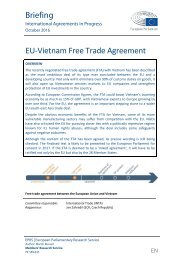A guide to EU procedures for the conclusion of international trade agreements
4bd7306n7zx
4bd7306n7zx
Create successful ePaper yourself
Turn your PDF publications into a flip-book with our unique Google optimized e-Paper software.
EPRS<br />
<strong>EU</strong> <strong>procedures</strong> <strong>for</strong> <strong>conclusion</strong> <strong>of</strong> <strong>international</strong> <strong>trade</strong> <strong>agreements</strong><br />
Voting procedure in <strong>the</strong> Council<br />
Voting procedure in Council under Article 218(8) TF<strong>EU</strong><br />
<strong>EU</strong>-Ukraine Association Agreement: provisional application and ratification procedure<br />
The <strong>EU</strong>-Ukraine Association Agreement, negotiated between 2007 and 2012, has been partly<br />
provisionally applied since 2014, while <strong>the</strong> provisional application <strong>of</strong> <strong>the</strong> commercial part <strong>of</strong> <strong>the</strong><br />
Association Agreement began on 1 January 2016. The provisional application currently applies<br />
only <strong>to</strong> <strong>EU</strong> competences. In order <strong>to</strong> enter fully in<strong>to</strong> <strong>for</strong>ce, <strong>the</strong> <strong>EU</strong>-Ukraine Association Agreement,<br />
being a mixed agreement, requires <strong>the</strong> ratification procedure <strong>to</strong> be complete at <strong>EU</strong> and also at<br />
Member State level. At <strong>EU</strong> level, <strong>the</strong> EP has given its consent <strong>for</strong> <strong>the</strong> Council <strong>to</strong> conclude <strong>the</strong><br />
agreement in two different resolutions (one covering treatment <strong>of</strong> third-country nationals and<br />
one covering <strong>the</strong> o<strong>the</strong>r provisions). The Council is waiting <strong>for</strong> <strong>the</strong> Member States <strong>to</strong> finalise <strong>the</strong><br />
ratification process in order <strong>to</strong> <strong>for</strong>mally adopt its decision on <strong>the</strong> <strong>conclusion</strong> <strong>of</strong> <strong>the</strong> agreement. All<br />
Member States, with <strong>the</strong> exception <strong>of</strong> <strong>the</strong> Ne<strong>the</strong>rlands, have ratified <strong>the</strong> Treaty.<br />
The Ne<strong>the</strong>rlands held an advisory referendum on <strong>the</strong> <strong>EU</strong>-Ukraine Association Agreement on<br />
6 April 2016, which yielded a negative result (over 61 % <strong>of</strong> <strong>the</strong> voters rejected <strong>the</strong> ratification <strong>of</strong><br />
<strong>the</strong> Association Agreement (AA) between <strong>the</strong> <strong>EU</strong> and Ukraine, though turnout was low, at only<br />
32 %). The referendum was an advisory referendum and as such has not put an end <strong>to</strong> <strong>the</strong><br />
ratification procedure in <strong>the</strong> Ne<strong>the</strong>rlands. However, should <strong>the</strong> Ne<strong>the</strong>rlands notify its intention<br />
not <strong>to</strong> ratify <strong>the</strong> agreement, this would <strong>the</strong>n signify that <strong>the</strong> <strong>EU</strong>-Ukraine Association Agreement<br />
could not enter in<strong>to</strong> <strong>for</strong>ce in its present <strong>for</strong>m. Under Article 25 <strong>of</strong> <strong>the</strong> Vienna Convention on <strong>the</strong><br />
Law <strong>of</strong> Treaties, provisional application can only remain pending <strong>the</strong> entry in<strong>to</strong> <strong>for</strong>ce <strong>of</strong> a treaty.<br />
If ratification fails and entry in<strong>to</strong> <strong>for</strong>ce <strong>of</strong> <strong>the</strong> treaty becomes impossible, provisional application<br />
would also have <strong>to</strong> be lifted. Suspension <strong>of</strong> <strong>the</strong> provisional application would have <strong>to</strong> be carried<br />
out in accordance with Article 218(9) TF<strong>EU</strong> and <strong>the</strong> notification procedure under Article 486(7) <strong>of</strong><br />
<strong>the</strong> <strong>EU</strong>-Ukraine Association Agreement. As has been done in <strong>the</strong> past, <strong>the</strong> Commission could<br />
argue on <strong>the</strong> basis <strong>of</strong> <strong>the</strong> duty <strong>of</strong> cooperation that <strong>the</strong> provisional application, which concerns <strong>EU</strong><br />
competences only, should be maintained in order <strong>to</strong> allow renegotiation and <strong>to</strong> find a mutually<br />
acceptable solution.<br />
The voting rule <strong>for</strong> Council decisions is contained in Article 218(8) TF<strong>EU</strong>. It refers <strong>to</strong> <strong>the</strong><br />
Council voting procedure throughout <strong>the</strong> entire process <strong>of</strong> negotiating and concluding<br />
<strong>international</strong> <strong>agreements</strong> under Article 218 TF<strong>EU</strong>. These voting rules <strong>the</strong>re<strong>for</strong>e apply<br />
equally <strong>to</strong> Council decisions taken pursuant <strong>to</strong> Article 218(5) TF<strong>EU</strong> in order <strong>to</strong> sign and<br />
provisionally apply a treaty, and <strong>to</strong> Council decisions taken pursuant <strong>to</strong> Article 218(6)<br />
TF<strong>EU</strong> <strong>to</strong> conclude an agreement. Although in practice <strong>the</strong> Council tries <strong>to</strong> take all decisions<br />
regarding shared competences on <strong>the</strong> basis <strong>of</strong> <strong>the</strong> 'common accord' <strong>of</strong> all Member States<br />
(i.e. by consensus), <strong>the</strong> voting procedure under <strong>the</strong> TF<strong>EU</strong> does not depend on <strong>the</strong> nature<br />
<strong>of</strong> <strong>the</strong> agreement but on <strong>the</strong> competences and legal basis upon which <strong>the</strong> agreement is<br />
adopted.<br />
Article 218(8) TF<strong>EU</strong> states that qualified majority must be used throughout <strong>international</strong><br />
agreement negotiation and <strong>conclusion</strong> <strong>procedures</strong>. There are some exceptions <strong>to</strong> this<br />
qualified majority rule; <strong>the</strong>se include <strong>the</strong> following situations or <strong>agreements</strong>.<br />
<br />
Fields <strong>for</strong> which unanimity is required <strong>for</strong> <strong>the</strong> adoption <strong>of</strong> a Union act: Any measure<br />
which requires unanimity <strong>for</strong> <strong>the</strong> purpose <strong>of</strong> <strong>EU</strong> internal legislation, will also<br />
require unanimity <strong>for</strong> any decisions taken under Article 218 TF<strong>EU</strong>. In practice, this<br />
rule provides <strong>for</strong> parallel decision-making on external policy and <strong>EU</strong> internal<br />
legislative <strong>procedures</strong>. This rule on parallelism ensures that <strong>the</strong> <strong>EU</strong> internal<br />
legislation procedure requiring unanimity <strong>for</strong> certain measures is not<br />
Members' Research Service Page 8 <strong>of</strong> 10




